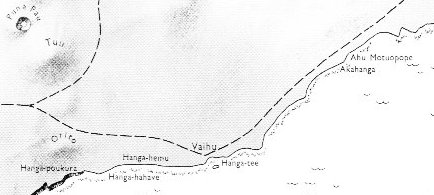|
ADDENDA
222. Yesterday it was April 1 (92, *1) AD 2024 (a leap year). It also 'happened to be' the day after Easter Sunday. And as if by chance I found a TV program about the 'Mysteries' on Easter Island. They meant the statues (moai). Much was well known and a bit to simplified, superficial, and even arrogant for my taste. Nowadays nothing will ever be done thoroughly, it seems. And no one will ever give due credit to any of the many great earlier investigators. But they claimed to have solved the moai mystery, and I believe they were right. After having excluded alternative possibilities they at last had found a pattern. Most of the statues were located at a place where sweet water could be obtained. As they explained it: Captain Cook had been wrong when he said that the Easter Islanders went down to the sea in order to drink from the salty water. They instead went down to the places where underground sweet water streams from the interior of the island finally emerged and flowed out on top of the sea water. Sweet water is lighter than salty water and therefore it flowed on top. Here I associated to how Fakataka on the freshwater pools of the reef gave birth to Taetagaloa. And I also thought of how in Manuscript E it was stated that the last chapter in the life of king Hotu A Matua was to dig sweet water wells close to the shore. But I was wrong. It had not been described directly in Manuscript E. Instead I had read about the last efforts of king Hotu on page 222 in Barthel's The Eighth Land. "Among Hotu Matua's last accomplishments were his attempts to dig wells (anga i te vai, TP:53) along the shore of Akahanga." And indirectly we have indeed found evidence which connects the beginning of the kuhane station named Akahanga with August 14, 5 Imix 9 Kumk'u, the Head of the Lion - at Ras Elaset Australis (*146, 226 = 222 + 4).
|
